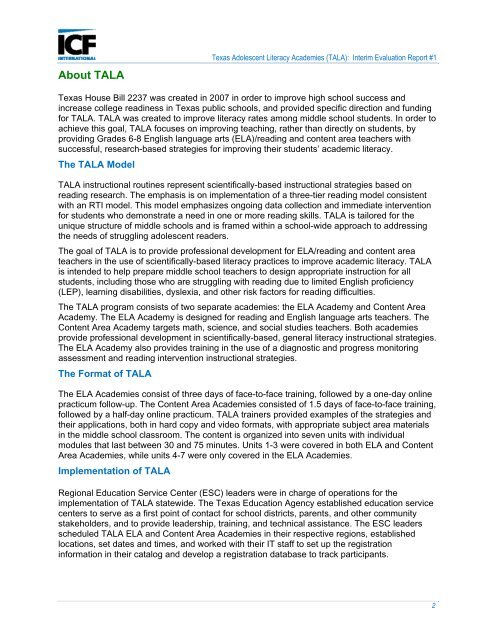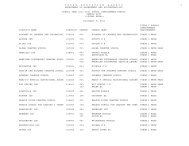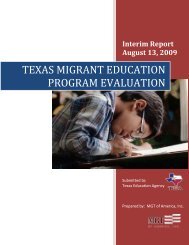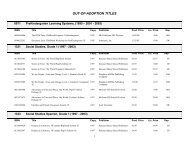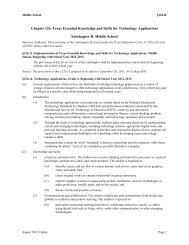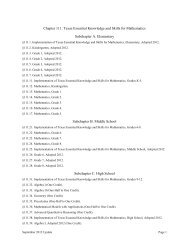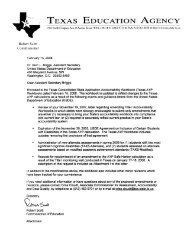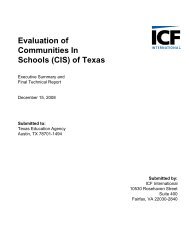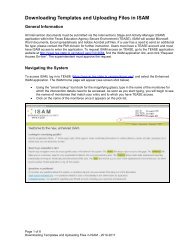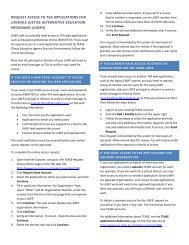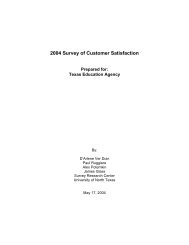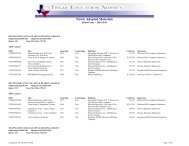Evaluation of the Texas Adolescent Literacy Academies (TALA ...
Evaluation of the Texas Adolescent Literacy Academies (TALA ...
Evaluation of the Texas Adolescent Literacy Academies (TALA ...
- No tags were found...
You also want an ePaper? Increase the reach of your titles
YUMPU automatically turns print PDFs into web optimized ePapers that Google loves.
About <strong>TALA</strong><strong>Texas</strong> <strong>Adolescent</strong> <strong>Literacy</strong> <strong>Academies</strong> (<strong>TALA</strong>): Interim <strong>Evaluation</strong> Report #1<strong>Texas</strong> House Bill 2237 was created in 2007 in order to improve high school success andincrease college readiness in <strong>Texas</strong> public schools, and provided specific direction and fundingfor <strong>TALA</strong>. <strong>TALA</strong> was created to improve literacy rates among middle school students. In order toachieve this goal, <strong>TALA</strong> focuses on improving teaching, ra<strong>the</strong>r than directly on students, byproviding Grades 6-8 English language arts (ELA)/reading and content area teachers withsuccessful, research-based strategies for improving <strong>the</strong>ir students’ academic literacy.The <strong>TALA</strong> Model<strong>TALA</strong> instructional routines represent scientifically-based instructional strategies based onreading research. The emphasis is on implementation <strong>of</strong> a three-tier reading model consistentwith an RTI model. This model emphasizes ongoing data collection and immediate interventionfor students who demonstrate a need in one or more reading skills. <strong>TALA</strong> is tailored for <strong>the</strong>unique structure <strong>of</strong> middle schools and is framed within a school-wide approach to addressing<strong>the</strong> needs <strong>of</strong> struggling adolescent readers.The goal <strong>of</strong> <strong>TALA</strong> is to provide pr<strong>of</strong>essional development for ELA/reading and content areateachers in <strong>the</strong> use <strong>of</strong> scientifically-based literacy practices to improve academic literacy. <strong>TALA</strong>is intended to help prepare middle school teachers to design appropriate instruction for allstudents, including those who are struggling with reading due to limited English pr<strong>of</strong>iciency(LEP), learning disabilities, dyslexia, and o<strong>the</strong>r risk factors for reading difficulties.The <strong>TALA</strong> program consists <strong>of</strong> two separate academies: <strong>the</strong> ELA Academy and Content AreaAcademy. The ELA Academy is designed for reading and English language arts teachers. TheContent Area Academy targets math, science, and social studies teachers. Both academiesprovide pr<strong>of</strong>essional development in scientifically-based, general literacy instructional strategies.The ELA Academy also provides training in <strong>the</strong> use <strong>of</strong> a diagnostic and progress monitoringassessment and reading intervention instructional strategies.The Format <strong>of</strong> <strong>TALA</strong>The ELA <strong>Academies</strong> consist <strong>of</strong> three days <strong>of</strong> face-to-face training, followed by a one-day onlinepracticum follow-up. The Content Area <strong>Academies</strong> consisted <strong>of</strong> 1.5 days <strong>of</strong> face-to-face training,followed by a half-day online practicum. <strong>TALA</strong> trainers provided examples <strong>of</strong> <strong>the</strong> strategies and<strong>the</strong>ir applications, both in hard copy and video formats, with appropriate subject area materialsin <strong>the</strong> middle school classroom. The content is organized into seven units with individualmodules that last between 30 and 75 minutes. Units 1-3 were covered in both ELA and ContentArea <strong>Academies</strong>, while units 4-7 were only covered in <strong>the</strong> ELA <strong>Academies</strong>.Implementation <strong>of</strong> <strong>TALA</strong>Regional Education Service Center (ESC) leaders were in charge <strong>of</strong> operations for <strong>the</strong>implementation <strong>of</strong> <strong>TALA</strong> statewide. The <strong>Texas</strong> Education Agency established education servicecenters to serve as a first point <strong>of</strong> contact for school districts, parents, and o<strong>the</strong>r communitystakeholders, and to provide leadership, training, and technical assistance. The ESC leadersscheduled <strong>TALA</strong> ELA and Content Area <strong>Academies</strong> in <strong>the</strong>ir respective regions, establishedlocations, set dates and times, and worked with <strong>the</strong>ir IT staff to set up <strong>the</strong> registrationinformation in <strong>the</strong>ir catalog and develop a registration database to track participants.2


